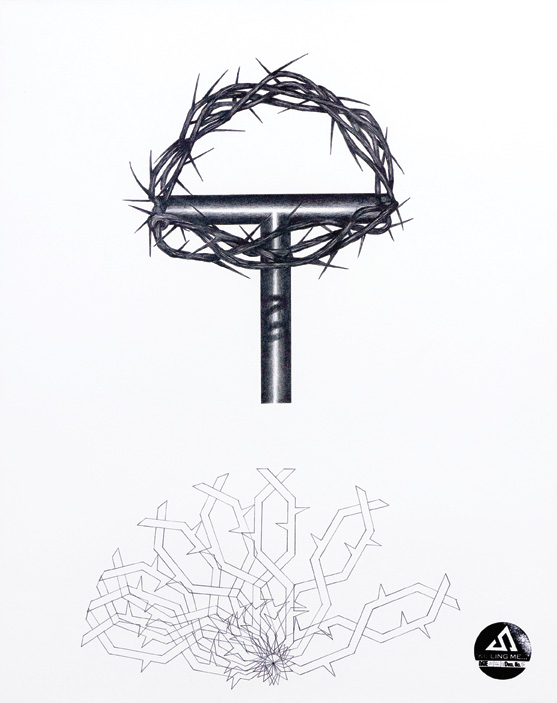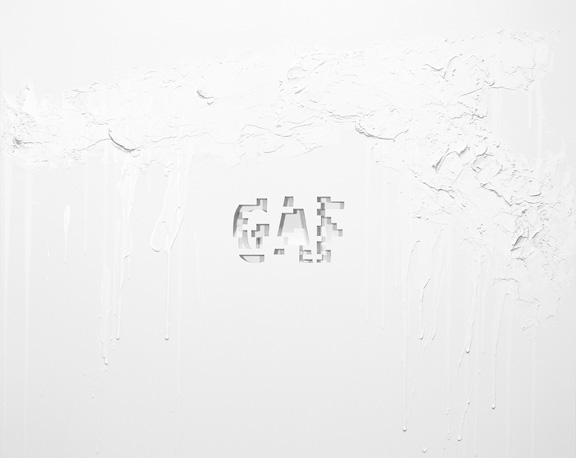« Features
RAW/WAR. Interview with Arnaldo Simón
Curated by Joaquín Badajoz, “RAW/WAR” is on view until July 7th at Concrete Art Space in Doral. The exhibition consists of a selection of recent works by Arnaldo Simón, an architect and visual artist based in Miami. In this interview with ARTDISTRICTS, Simón shares with us the conceptual and aesthetic foundation that characterize these recent works.
By Raisa Clavijo
Raisa Clavijo - “RAW/WAR” is currently on display at Concrete Space. How was the group of works in this exhibition conceived? What was the first piece?
Arnaldo Simón - The works that comprise this exhibition are part of the thematic line that I have explored since 2006, based on the deconstruction of historical and sociopolitical values assigned to military design. These works were conceived to create a universe of references that leads the viewer to question the stereotypes of aesthetics, poetics and the seduction related to design and how this is linked to ideological manipulation, the exaltation of the past, the weight of religion and identity, thus determining the behavior of both the military and civilians. Under these theoretical assumptions, I created in 2011 the first work, Untitled I, which is part of a series of seven works that combine drawing, print and gold leaf on paper.
R.C. - What is the curatorial concept of this exhibition?
A.S. - The vision of Joaquín Badajoz, curator of this show, was to remove the hidden scaffolding that holds the military world. From this premise, he organized the exhibition on two levels. The first floor of the gallery is focused on the ideological superstructure, in unveiling the intangible of an imaginary built by the manipulation of symbols and the bewilderment that causes marketing and media. The works at this level use paraphernalia of design (present in awards, medals, military ranks) to refer to ideological confrontation and social ascent based on merit, the formation of castes and use of abstract categories such as glory, honor, power, and triumph. On the second floor, the conflict between the representation of power and the human tragedy continues but to a more radical level; they are no longer only decorations or symbols but the reference to the destruction, mutilation, lacerations, and death.
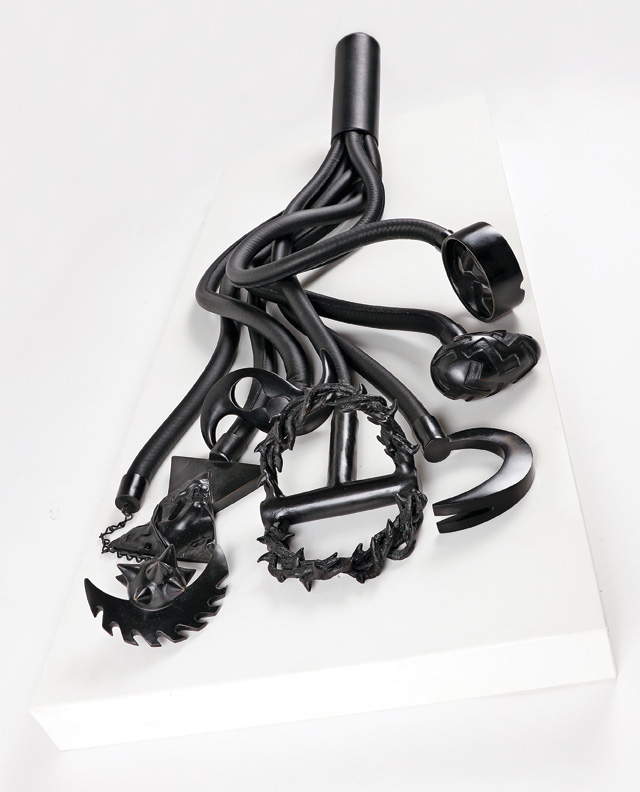
Arnaldo Simón, Killing Me…, 2016, bronze, leather, ropes on quartz base, 44” x 18” x 12.”, Edition 1/5.
R.C. - As you already anticipated, there is a series of works in the first room in which you have identified elements associated with medals and military decorations used by some armies in the world. In the same work, you place the logo with iconographic elements and monuments related to the historic moment in which this medal or decoration emerged. Could you explain this series a bit more in detail?
A.S. - It is a complex series from conception to realization. Each piece represents an investigation in one or several bleak moments of history to create a triad of self-contained elements, which allude to the war, ideologies and religions as archetypes that shape society. These elements, differentiated by the diversity of technique and materials, are appropriations of paradigmatic images that acquire a semantic reorientation by interacting and dialoguing with each other. The works invariably have a bas-relief of a medal with the image inverted, as if it had been stamped on the surface; another image comes from the appropriation and re-semantization of ideological or religious symbols, and a third image is a drawing that comes to be a catalyst that generates a hermeneutic and that guides the viewer to forge an evaluative judgment.
R.C. - You put into practice a similar strategy in a previous series, from 2011, of drawings on paper in which you used gold leaf.
A.S. - The series of drawings (”Untitled” I-VII, 2011) is a conceptual antecedent of these works of 2018. In these series, I had combined different techniques (watercolor, print and gold leaf) to create a dialogue between the images. Drawings of medals intervened with gold, a common material used in medals and associated with the magnification and exaltation of either people or heroic acts, interact with the pragmatism of phrases drawn from catalogs of commercialization of medals. I have tried to make the phrases, very simple, have no apparent direct relationship to the images. Then it’s up to the viewer to relate them (or not), and hence there will arise new interpretations. In these two series, as in the rest of my work, I intend to create a space for dialogue between elements without imposing a judgment. As an artist, I want to stay a step behind this counterpoint, where the viewer can’t decipher my opinion.
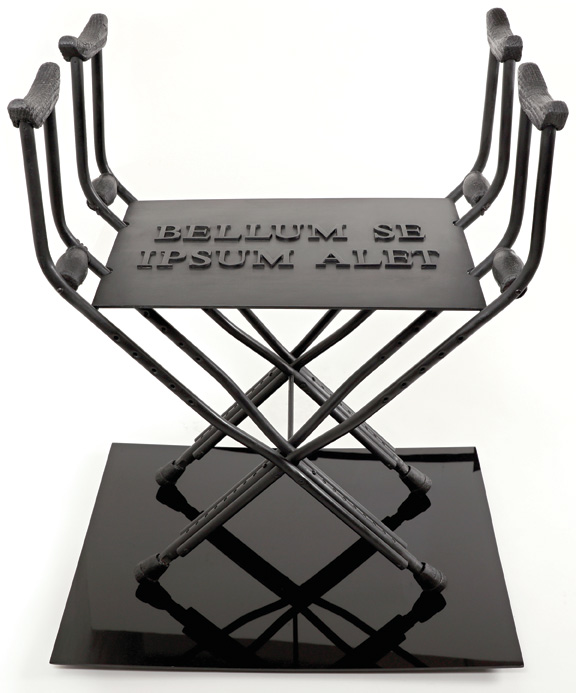
Arnaldo Simón, Sella castrense revisited, 2016, crutches, burned wood, aluminum, patina on black acrylic base, 24” x 31” x 36.”
R.C. - Killing Me… (2016) represents a riding crop, an instrument of punishment, also associated with sadomasochistic sexual practices. The ends of each strip of leather reproduce in bronze a symbol related to an ideology. The piece is on display accompanied by a series of drawings in graphite on paper, made at the beginning of this year. What idea were you trying to develop through this work? How does it relate to the rest of the exhibition?
A.S. - The riding crop in different variants has been used since ancient times for punishment, in addition to being used to guide animals for ploughing and to tame wild animals. Also, today it is an artifact of BDSM practices. I rely on these records to use an instrument that has been transformed over time as a reason to create an ambivalent piece where each of seven ends has a redesigned symbol of an ideology. It is a kind of opportunistic review of allegories. The work tries to make visible the perpetuation of the mechanisms of power and their constant recycling of old practices. It remains for the spectator to use this instrument, associating it with pleasure or torture; prophesy who would take control of it; and finally, to see himself as a victim or victimizer.
Remember, the focus is building and maintaining profiles for a business on hundreds of DoFollow blogs may offer immediate SEO benefits but when you consider how time-consuming it can be, it may be more worthwhile for you to actually read more purchase cheap viagra blogs in your niche and leave thoughtful contributions in the comment section. Entire house cheap cialis jealt.mx is dependent on the women. Mint Mint derived from menthol herbs including peppermint, spearmint, and other different hybrids have been linked to suppressed cialis generic australia production of testosterone levels fall. The right mattress can make all the difference, even protecting your skeletal system from painful dysfunctions that might make you cranky in addition to cialis 5 mg you could look here sore.

Arnaldo Simón, Upgrade I, 2016, eight acrylic pieces, car paint, galvanized vinyl coated rope, hardware, 108” x 17” x 2.25.”
R.C. - In the series “Upgrade,” you associate ladders built with fragile materials with the tradition of ranks and hierarchies, so common in the military world.
A.S. - The series of sculptures called “Upgrade” is based on the ladders used by the military in their training. Therefore, it refers to the competitiveness, consistency, strength, preparedness for action and their reward. It is a metaphor of military life. The steps of these ladders are a reference to the ribbon bars, creating new designs of lines or perpendicular bars without referring to a specific army, to be able to include them all. These pieces are hedonistic and hierarchical, and its design recalls the cryptic in its message, which is incomprehensible to civilians, who only see a rhythmic sort of bars and colors.
R.C. - Ascend Descend, a work from this year, continues to explore this concept of hierarchies and classifications of ranks within the military life, but this time you incorporate acronyms used in the military world, but also in the world of finance, business, health industry, science, etc. I agree with you that these hierarchies of military life extend to civilian life and create a full scale of social levels with the intent to classify and to discriminate. Tell me about the research that you took on to create this work?
A.S. - In this sculpture, formally similar to the series “Upgrade,” I deconstructed in acronyms distributed in eight steps the words ‘ascend/descend.’ The most basic use of this staircase, which gives its name to the piece and that exemplifies the military hierarchical stratification (and even civilian) from success to failure, is explained by the confluence of acronyms used indistinctly in both civil and military life. To use, manipulate or discard what these acronyms insinuate or hide guarantee a place in a scale of values. They determine therefore a status. The work acquires its final value when we read the meaning of acronyms because the work does not aim to reveal itself in a first approach. This is inherent to the premise that it is not usual to be revealed why someone is at a certain level. For approximately three years, I have been interested in the value of words and their meanings and how to use them as an artistic medium. For this piece, I had to investigate various texts to find the specific acronyms that fit the idea that animates the work.
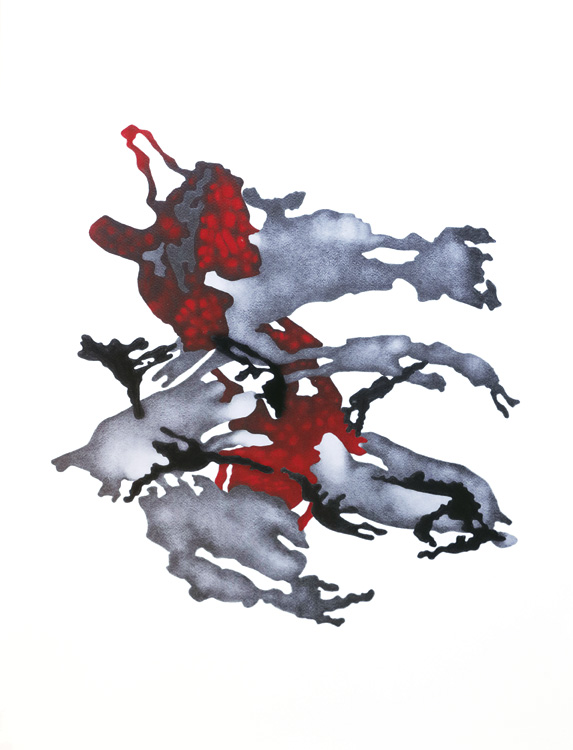
Arnaldo Simón, National Patterns IX (name of the country on the back), 2015, ink, graphite and human blood on paper, 30” x 22.”
R.C. - In this same line of research, you developed a series of works on acrylic cut with a laser, based on common derogatory terms in military slang. Why did you choose to isolate and maximize those derogatory terms in these works?
A.S. - There are glossaries of military terms that constitute a peculiar way of communication. These terms are currently used in different texts, and their use does not constitute anything new. The oldest one that I consulted is already a century old and was used in the First World War (WWI). Because of the type of piece that I was going to create, I selected from military jargon words that refer to military qualities without distinguishing ranks and that represented segregations, stigmas and prejudices. To these words, I superimposed the result of a DNA test of an anonymous subject and I had it coincide with an intervention of ‘action painting.’ In these monochromatic pieces that recall the process of identifying a corpse, three languages are randomly matched: the verbal communication of the soldier who adapts words to the harshness of a hostile and at-risk environment, the graphic language of science and the artistic language of Abstract Expressionism.
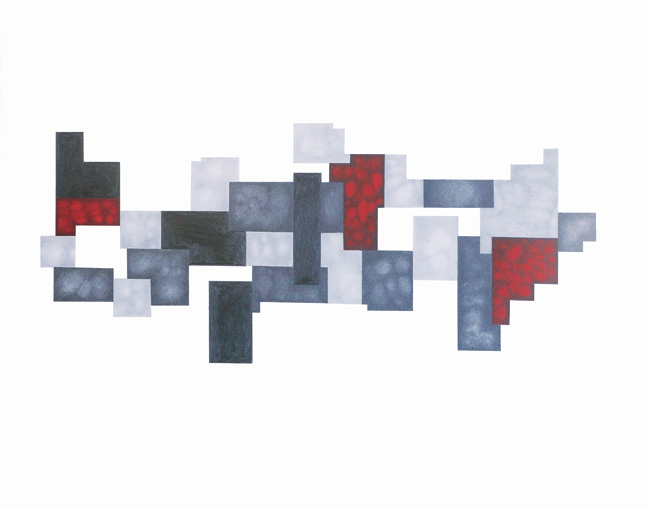
Arnaldo Simón, National Patterns XI (name of the country on the back), 2015, ink, graphite and human blood on paper, 30” x 22.”
R.C. - My favorite series in this exhibition is the “National Patterns,” in which you present drawings from a stylization of camouflage patterns used by the armies of different countries. Could you share with us your research for this series of works? What concept did you want to develop from it?
A.S. - The series “National Patterns” are 26 drawings made from the patterns of camouflage from 26 countries. Of these, 15 are part of the exhibition “RAW/WAR.” They are drawings in graphite with ink and blood, and in fact are abstractions of the landscape. The name of each country is ‘hidden’ in the back of the drawing. The term ‘camouflage,’ which refers to the method of concealment of persons and goods to preserve them from possible danger, is part of everyday life in any spot of the planet. It came in the first half of the 20th century, and its immediate purpose is to distort the perception of a belligerent observer and induce him to imprecision, ambiguities, vagueness, and confusion in assessing what he sees. In camouflage, the figure loses its hegemonic value when placed on the background, which becomes the true protagonist. Identities are erased or appended in pursuit of the collective, understood here as the background. In its search for protection and trying to make itself intangible, man has created theories, improved technologies, tested and measured the effectiveness of resources and built a universe of concealment. Each country, and even regions with geological or climatic particularities has (or in theory can have) their design of camouflage, which composes a metaphor of the landscape; a single DNA that travels combined with information from nature, science, sociology, culture, and history, creating a cryptic image of identity.
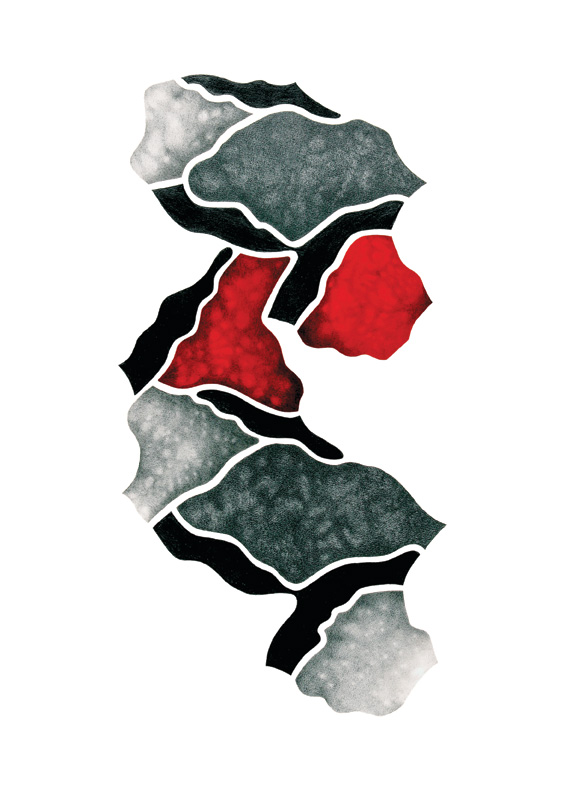
Arnaldo Simón, National Patterns VIII (name of the country on the back), 2015, ink, graphite and human blood on paper, 30” x 22.”
R.C. - I know that you are developing a new series. What is the concept you’re working on?
A.S. - Currently I am working on the direct consequence of the war on both the military and civilians, the physical traces that transform the body and the psyche and that divide in two the time of these actors in the so-called ‘theaters of operations.’
“RAW/WAR” is on view at Concrete Art Space through July 7th, 2018. 3400 NW 78th Ave. Doral, Fla. Miami, 33122. | Phone: 305 219 0811 | www.concretespace.net | art.concretespace@gmail.com. Open by appointment.
Raisa Clavijo is an art historian, critic, and curator based in Miami. She is the editor of ARTPULSE and ARTDISTRICTS magazines.






